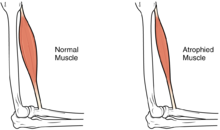
Back ضمور اللحم Arabic Sarkopeniya Azerbaijani Sarkopenija BS Sarcopènia Catalan Sarkopenie German Sarcopenia Spanish Sarkopeenia Estonian کمماهیچگی Persian Sarkopenia Finnish Sarcopénie French
| Sarcopenia | |
|---|---|
 | |
| Difference between a normal muscle and an atrophied muscle | |
| Specialty | Geriatrics Rheumatology |
Sarcopenia (ICD-10 code M62.84) is a type of muscle loss that occurs with aging and/or immobility. It is characterized by the degenerative loss of skeletal muscle mass, quality, and strength. The rate of muscle loss is dependent on exercise level, co-morbidities, nutrition and other factors. The muscle loss is related to changes in muscle synthesis signalling pathways. It is distinct from cachexia, in which muscle is degraded through cytokine-mediated degradation, although the two conditions may co-exist. Sarcopenia is considered a component of frailty syndrome.[1] Sarcopenia can lead to reduced quality of life, falls, fracture, and disability.[2][3]
Sarcopenia is a factor in changing body composition. When associated with aging populations, certain muscle regions are expected to be affected first, specifically the anterior thigh and abdominal muscles.[2][4] In population studies, body mass index (BMI) is seen to decrease in aging populations while bioelectrical impedance analysis (BIA) shows body fat proportion rising.[5]
- ^ Peterson SJ, Mozer M (February 2017). "Differentiating Sarcopenia and Cachexia Among Patients With Cancer". Nutrition in Clinical Practice. 32 (1): 30–39. doi:10.1177/0884533616680354. PMID 28124947. S2CID 206555460.
- ^ a b Ata AM, Kara M, Kaymak B, Özçakar L (October 2020). "Sarcopenia Is Not "Love": You Have to Look Where You Lost it!". American Journal of Physical Medicine & Rehabilitation. 99 (10): e119–e120. doi:10.1097/PHM.0000000000001391. PMID 32084033. S2CID 211245329.
- ^ Beaudart C, Zaaria M, Pasleau F, Reginster JY, Bruyère O (2017). "Health Outcomes of Sarcopenia: A Systematic Review and Meta-Analysis". PLOS ONE. 12 (1): e0169548. Bibcode:2017PLoSO..1269548B. doi:10.1371/journal.pone.0169548. PMC 5240970. PMID 28095426.
- ^ Ata AM, Kara M, Kaymak B, Gürçay E, Çakır B, Ünlü H, et al. (2019). "Regional and total muscle mass, muscle strength and physical performance: The potential use of ultrasound imaging for sarcopenia". Archives of Gerontology and Geriatrics. 83: 55–60. doi:10.1016/j.archger.2019.03.014. PMID 30953961. S2CID 96463073.
- ^ Ranasinghe C, Gamage P, Katulanda P, Andraweera N, Thilakarathne S, Tharanga P (September 2013). "Relationship between Body Mass Index (BMI) and body fat percentage, estimated by bioelectrical impedance, in a group of Sri Lankan adults: a cross sectional study". BMC Public Health. 13: 797. doi:10.1186/1471-2458-13-797. PMC 3766672. PMID 24004464.
© MMXXIII Rich X Search. We shall prevail. All rights reserved. Rich X Search